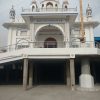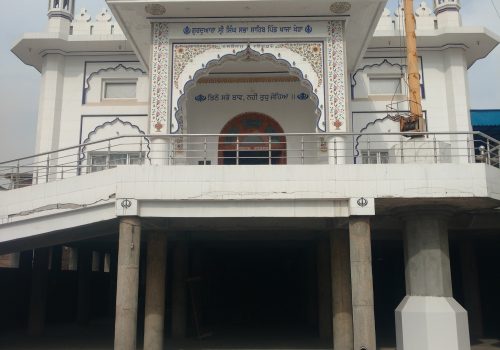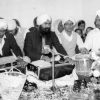NALUCHHI, a village three kilometres west of Muzaffarabad in Pakistanoccupied Kashmir, had a gurudwara commemorating Guru Hargobind who had visited the village during his visit to Kashmir in 1620. Maharaja Ranjit Singh had made out to it a land grant worth Rs 3,000 annually. Baisakhi was observed as a religious festival in the gurudwara until its evacuation in the wake of invasion by Pakistansupported tribal raiders in October 1947.
MADHO SINGHANA is a village 15 km south of Sirsa in Haryana. Guru Gobind Singh after leaving Sirsa towards the South made his first halt here. As the village was totally populated by Muslims, no memorial shrine existed until a lone Nihang Singh established a gurdwara during the 1970\'s along the road leading to Ellenabad.
KOLAYAT, popularly pronounced Kulait, a town 52 km southwest of Bikaner (28"04`N, 73021`E), is famous for a temple dedicated to Kapila Muni, an ancient Hindu sage to whom the Sankhya system of philosophy is attributed. According to Sikh chroniclers, Guru Nanak visited Kolayat. Guru Gobind Singh, at the time of his travels through Rajasthan, is said to have stayed here for twelve days. Here Bhai Daya Singh and Bhai Dharam Singh, who had been to Ahmadnagar to deliver to Emperor Aurahgzib the Zafamamah, the Guru`s letter in Persian verse, rejoined him. However, no Sikh shrine existed here until 1968 when some Sikh residents of the area, led by a Sikh colonizer of Kolayat, acquired a plot of land and constructed a Gurudwara. The Gurudwara is a modest oneroom building with a paved platform all around it. Sikh settlers of the surrounding area gather to celebrate Guru Nanak`s birth anniversary on the fullmoon day of Kartik (OctoberNovember) every year.
KOT BHAI, village 7 km northeast of Giddarbaha (30°12`N, 74°39`E) in Faridkot district of the Punjab, is named after Bhai Bhagatu, a devout Sikh who served the Fifth, Sixth and the Seventh Gurus. When Guru Gobind Singh (16661708) visited the village in 1706, two bdmds, i.e. shopkeeperscummoneylenders, Rangi and Ghummi by name, served him with devotion and begged to be initiated into the order of the Khalsa. There are two Gurudwaras commemorating the Guru`s visit one inside the village where those two Sikhs resided, and the other on the eastern end of the village marking the site where Guru Gobind Singh had camped. Both shrines are controlled by the Shiromani Gurdwara Parbandhak Committee through a local committee.
KOTHA GURU, famous old village of the Punjab, announces its antiquity through the existence on its outskirts of a deserted ancient mound. This bulbous mountain of sand dominates the entire skyline of the village concealing within its folds many a layer of distant history. Once upon a time this sprawling old mound was the scat of the Mans, still called in those parts by their old name of "Manhas." The modern period of the village begins with the acquisition of the village site from the Mughal emperor Jaharigir by Baba Prithi Chand of the line of the Sodhis. The earlier name of Kothe Prithi Chand Kc was changed to Kotha Guru by Guru Gobind Singh. The story is also current about the Mughal official SulhI Khan who met with a painful death in a burning fire. He had allowed his horse to run loose over the halfburnt bricks of a kiln. The fact is attested by a line in the Guru Granth Sahib itself (GG, 825). In the time of Baba Prithi Ghand`s son Miharban, the place became a centre of learning and many weighty manuscripts emanated from here. Among them were the Costs of the Bhagats and BJiagat Barn Pammdrtha and Polhi Sac)i Khand which is aJanam Sakhi or life story of Guru Nanak. Miharban`s son and his younger brother wrote commentaries on the sacred texts. Sodhi Abhay Singh who lived in Kotha Guru wrote his monumental Harjas Granth. Sodhi Faujdar Singh was another charismatic character. He had been allowed by the Maharaja of Patiala to keep with him as a special privilege a body of 100 horsemen. In the Singh Sabha days, Pandit Indar Singh of Kotha Guru became famous for his learned commentary on an old Sanskrit text "Aushnash Simrti."
KHADUR SAHIB, an old village 19 km cast ofTarnTaran (31°27`N, 74"56`E) in Amrilsar district of the Punjab, is sacred to the first three Gurus. Guru Nanak is said to have visited Khadiir once to meet his disciple, Bhai Jodha, a Khaihra Jatt. It was through Bhai Jodha`s example that Bhai Lahina (later, Guru Angad) was led to seek Guru Nanak`s precept. Guru Angad`s father, Baba Pheru, liaving left his ancestral place, MaltcdiSarai, and the temporary abode at Harikc, had made Khadur his home. Baba Pheru`s sister Mai BharaT was already married in Khadur; his son, Bhai Lahina, was now married here in 1519. After the anointment of Bhai Lahina as Guru Angad in 1539, he, following Guru Nanak`s instructions, returned to Khadur, which became the centre of the Sikh faith. He stayed here till his death in 1552. It was at Khadur thai Amar Das served him as a disciple and was in turn himself anointed Guru. Khadur Sahib has several gurudwaras commemorating the holy Gurus. GURDWARA TAPIANA SAHIB, 200 metres north of the village, marks the site where Guru Nanak, accompanied, according to local tradition, by Bhai Bala and Bhai Mardana, preached to a gathering of devotees. It was here again that the events of Guru Nanak`s life arc said to have been recorded, in the form of aJanam SakhT, as narrated by Bhai Bala. A small platform near the Gurdwara marks the spot where Bhai Bala`s mortal remains were cremated. The Gurdwara comprises a square hall on a high plinth. The Guru Granth Sahib is seated on a canopied throne of white marble. A lotus dome with an ornamental goldplated pinnacle and an umbrellashaped finial tops the hall, which also has a squareshaped domed kiosk above each of its corners. In front of the hall, in the middle of a oneacre brickpaved compound, is the sarovar. GURDWARA TAP ASTIIAN SRI GURU ANGAD DEV Ji, opposite Gurdwara Tapiana Sahib, marks the site where Guru Arigad used to sit in meditation. It is a square domed hall with domed cubicles at top corners. The central dome has a goldplated pinnacle, an umbrellashaped finial and a khandd at the apex. GURDWARA DARBAR SAHIB ANGITHA SAHIB, within a highwalled compound entered through an old twostoreyed gateway, comprises a square domed sanctum with a circumambulatory passage and a hall in the front. The sanctum marks the site where Guru Angad`s body was cremated. Close by is a square domed marble pavilion called Killa Sahib or Khaddi Sahib. This was a weaver`s pit, khaddi in Punjabi, where Baba (later Guru) Amar Das, carrying a pitcher of water for Guru Arigad during a pitch dark night, stumbled against a killa or peg. An old well near the gateway, is called Bibi AmaroJi da Khuh, or the Well of Bibi Amaro, Guru Angad`s daughter, whose hymnsinging had inspired Baba Amar Das to seek spiritual solace at the feet of Guru Angad. GURDWARA MAT BHARAl, about 100 metres to the west of Gurdwara Darbar Sahib, constructed where Mai Bharai`s house once stood, marks another site consecrated by Guru Angad. According to Sikh chronicles, Guru Angad, as he arrived at Khadur, from Kartarpur where Guru Nanak had anointed him his successor, decided to go into undisturbed meditation for some time. He did not go to his own house, but shut himself up in a small room in Mai Bharai`s house and locked the door from inside. Sangats that went to Kartarpur to sec the new Guru were led to Khadur by BhaT Buddha who, risking the Guru`s displeasure, tore a hole into one of the walls of the room in Mai Bharai`s house. He bowed at the Guru`s feet and announced how the Sikhs waited outside for a sight of him. Guru Angad came out of his temporary seclusion to meet the disciples. The new building of Gurdwara Mai Bharal, constructed during the 1980`s, is a highccilinged hall with a gallery at midheight. Its walls are lined with streaked marble slabs. The sanctum at the far end of the hall is topped by three storeys of square pavilions and a dome all covered with white gla`/ed tiles. GURDWARA MALL AKHARA, at the northern edge of the village, marks the site where wrestling bouts for the youth were held in the time of Guru Arigad. Mallakhdrd literally means wrestlers` pit. Here the Guru also taught children Gurmukhi letters. Even now young scholars are trained here in reciting the Guru Granth Sahib. The present building is a square domed hall within a lowwalled compound. GURDWARA THARA SAHIB GURU AMAR DAS, a small domed room, is built on a high plinth in the middle of a marblefloored platform. The Thara, platform in Punjabi, marks the spot where Baba (Guru) Amar Das used to sit in meditation when he was not physically engaged in serving Guru Arigad or his Sikhs. All these gurudwaras arc managed by the Shiromani Gurdwara Parbandhak Committee through a local committee.
KARTARPUR. village on the right bank of tlie River Ravi in the present Sialkot district of Pakistan and usually called Kartarpur Ravl to distinguish it from another town of tlie same name in Jalandhar district of Indian Punjab, is sacred to Guru Nanak (14691539) to whom it owed its origin and who settled here at the end of his long peregrinations in India and abroad to prcacli the word of God. Guru Nanak spent the last two decades of his life with his wife and children at Kartarpur which became the principal seat of the Sikh faith. It was here that Bhai Lahina, later Guru Arigad, came to receive instruction and it was here that, after nominating (Guru) Arigad his spiritual sucessor, he passed away on Assu vadi 10, 1596 Bk/7 September 1539. Most of the habitation was washed away by the everencroaching Ravi whereupon the Guru`s descendants and followers moved to Dera Baba Nanak, a new town they had raised on the other side of the river. The threestoreyed tall building ofGurdwara Kartarpur Sahib Ravi PatshahT I erected later at Kartarpur can still be seen from the high embankment marking the IndoPakistan boundary north ofDcra Baba Nanak, but it has been inaccessible to visitors and pilgrims from India since the partition of 1947.
KANGANPUR, a large village along KasurLodhrari railway line in Lahore district of Pakistan, had a historical Sikh shrine dedicated to Guru Nanak. Local tradition established Kariganpur as the locale of an episode given in the Purdtan Janam Sdkhi. It is said that once Guru Nanak accompanied by Bhai Mardana came to this village, but the villagers treated them with gross indifference. They did not even let them put up in the village. Before departing, the Guru blessed them saying, "Vasde mho May you live happily here" and went to the next village, Manak Deke, 3 km away. The inhabitants of this village warmly welcomed the visitors and extended to them their wonted hospitality. On leaving this village, Guru Nanak rcmakred, "Ujjarjdo May you be dispersed." Bhai Mardana was puxzlcd and questioned the Master about his strange way of blessing the wicked and cursing the virtuous. The Guru explained that in the former case he had wished the illmannered residents of Kariganpur to stay where they were, so that they did not spread their sullenness to people elsewhere, whereas he expected the people of Manak Deke to spread goodness by their gentle example. The Gurdwara Sahib at Kariganpur used to attract devotees especially on the first of every Bikrami month. It was the site of a largelyattended religious festival on the first of the month ofChet (midMarch) every year, until it was abandoned in AugustSeptembcr 1947 in consequence of the partition of India.
BHAGIRATH or Bhagirath, of Malsian, an old village in presentday Jalandhar district of the Punjab, who is recorded as being one of the early disciples of Guru Nanak, was according to Bhai Gurdas, Varan, XI. 14, known as a worshipper of the Goddess Kali. As the Janam Sakhis report, Bhagirath had served faqirs and sadhus and worshipped many gods and goddesses in quest of spiritual consolation. One night, it is stated, he went to sleep adoring the stoneidol in his room when he had a dream. A voice spoke to him that all his wanderings would cease if he were only to make a trip to Sultanpur, not far from his village, and meet Guru Nanak who was a chosen one and had not till then fully `revealed himself. Bhagirath, it is said, followed the direction and sought out Guru Nanak, at the evening prayer in his home at Sultanpur. He became a disciple and remained there spending his time praying and singing hymns with the sangat, the holy fellowship. His is one of the fewest names from among Sikhs of Guru Nanak`s Sultanpur days mentioned in the Janam Sakhis. From Sultanpur he was once sent on an errand by Guru Nanak to Lahore to make purchases for the wedding of Bhai Mardana`s daughter. According to Sarup Das Bhalla, Mahima Prakash, Bhagirath rejoined Guru Nanak and remained in attendance at Kartarpur where the Guru had settled down at the end of his extensive travels lasting about 20 years.
DHAKA (23 43N, 90 24` E), an old city now capital of Bangladesh, situated on the north bank of Burhi Ganga river, has shrines sacred to Guru Nanak and Guru Tegh Bahadur. Three such gurdwaras commemorating the visits of the Gurus to the city existed until the partition of the country in 1947, but only two of them are now extant GURDWARA NANAKSHAHI, situated in Ramna locality behind the Public Library adjoining the Dhaka University campus, marks the spot where Guru Nanak is believed to have preached at the time of his visit in 150708. A Sikh sangat grew up in the locality, then known as ShUja`atpur or Sujatpur.



